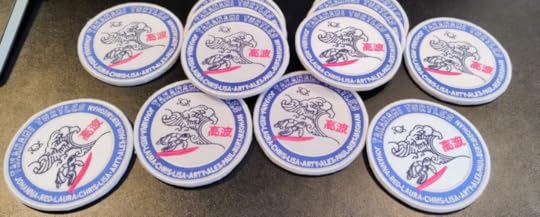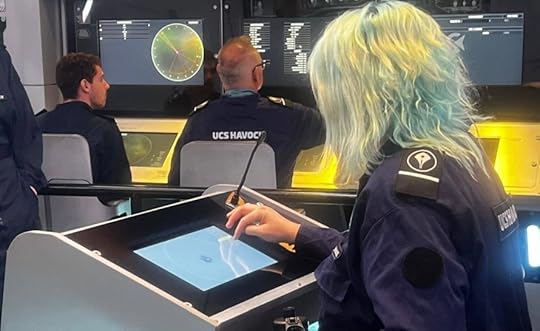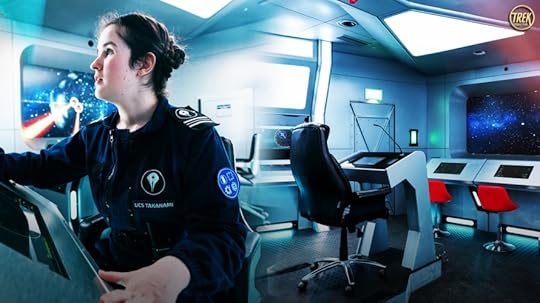Bridge Command Campaign 1 (The Conspiracy) Review
As an autistic person, it’s rare that I find myself not just enjoying but actively obsessed with a social event involving meeting and spending time with new people that I either don’t know, or who are relatively new to me.
Bridge Command in London is something of a mix between an escape room, a video game, a LARP event, and a piece of interactive theatre. Up to 14 people enter a building under Vauxhall station’s railway arches, get “teleported” to the Mess hall of the UCN Warspite, before teaming up to crew one of two interactive starship sets. Crews are given a briefing on one of 21 currently running missions (split between Diplomacy, Intrigue, Exploration, and Military), given a tour of the ship, assigned their roles on the crew, before engaging in between 90 minutes and 2 hours of collaborative storytelling and ship piloting adventures.
It’s safe to say, I’ve become pretty obsessed with Bridge Command in recent months. I first went for a friend’s Birthday earlier this summer, and since then have found myself squeezing in sessions whenever I can. While a lot of these visits have been with my wife Jane, I’ve also attended sessions with new friends I made at Bridge Command, and with players who were complete strangers at the start of the day.
Who would have thought essentially Star Trek LARPing would attract the kind of crowd that is, let’s say “compatibly neurodiverse”. I rarely find people this easy to interact with – The structured hierarchy of a clear chain of command, and a shared interest and objectives certainly help there.
I’ve gotten so into Bridge Command that the “captain’s log” I’ve been keeping, writing in character perspectives of each mission I’ve been on, has already crossed 25,000 words in length.
There’s narrative progression that takes place between visits, and in a short few months I’ve been promoted twice (from Ensign to Sub Lt, then to Lt), and earned special commendation medals for Diplomacy, Military Operations, and a General Commendation as captain of a particularly tricky mission.
I’ve also earned my first campaign star.
From my very first visit to Bridge Command, the concept of taking part in a multi-part campaign was incredibly up my alley. I’d heard rumours that one group of players, the Gobeys, had recently been the first to complete a 5 mission campaign as a group of ten, over the course of 5 weekly sessions. While there was a lot of secrecy about the nature of that campaign, it was known that they experienced a story that reportedly took advantage of the campaign format to do more elaborate types of missions, connected by a story that could expand more because all players involved could be guaranteed to have experienced the ongoing narrative. It had cost roughly the same as five regular mission bookings for a group of ten, so it seemed well worth giving a shot if I was already the kind of person likely to book five mission visits in the coming weeks regardless.
Within a week of my first Bridge Command visit I had found a campaign group willing to have me as their 10th player, the Takanami Turtles. They, however, were planning to cram the entire campaign into a single weekend. Ten hours of core missions in less than 50 hours.
 Custom patches for the Takanami Turtles crew, featuring crew names and a turtle surfing a wave in space.
Custom patches for the Takanami Turtles crew, featuring crew names and a turtle surfing a wave in space.Booking a campaign over a single weekend is obviously going to be more expensive than what most Bridge Command campaign groups do, weekly sessions on a quiet weeknight, by virtue of taking up a number of prime time booking slots. That said, a lot of the Takanami Turtles crew members are people who live too far from London for a weekly format to be viable, in many cases outside of the UK. The decision to cram the campaign into a weekend was logistical primarily, but did inevitably impact the pacing of the story we experienced. I think that pacing change was largely positive, but I don’t have the comparison point of a weekly campaign to say for certain – I’ll get to the specifics of that later.
By the time I found the Takanami Turtles, they were a fairly established group. They had a clear organiser who was very likely going to be our crew’s captain, and players who’d had some time to get to know each other. We used a spreadsheet to work out everyone’s preferences for roles, and assignments were sent out. I was to be the ship’s Navigator, First Officer (second in command under the Captain), and Helm (pilot) on the shuttle in the case of shuttle deployments.
The first time I met the Takanami Turtles in person was the day of our first campaign deployment. I suspect most people who organise a campaign won’t be teaming up with 9 people they’re already IRL friends with, but I also suspect most people organising campaigns will find opportunities to run missions with their campaign crew mates in advance of the big day. Obviously finding a group this way for a campaign involved rolling the dice a little, but ultimately it worked out really well in my case, I was paired up with a really lovely set of people. We all took the campaign fairly seriously, but were willing to have fun between sessions. We respected the chain of command, and knew how to be efficient in our job roles, while not being so experienced as to trivialise the tension of the missions ahead.
Now, before I dive further into my review of the first Bridge Command campaign, titled The Conspiracy, I want to be clear that I am keeping this review deliberately spoiler minimal. This is both to protect the surprise around some of the more unexpected moments the campaign contains, and because in character the UCN would probably demote me for talking too publicly about the specifics of a highly classified special operation.
There are places where my vagueness will limit my ability to explain the specifics that back up some of my opinions, but I do think that knowing as few specifics as possible about the campaign before it began ultimately increased my enjoyment.
 Captain Laura on the Havock, back on her first mission as an ensign.
Captain Laura on the Havock, back on her first mission as an ensign.To cut right to the heart of my opinion, Bridge Command really does an amazing job of making the most of the campaign format, truly highlighting what this storytelling adventure experience can be at its best. It captures the magic of the event’s continuity and magnifies it, showcasing elements of the set and game design toolset not commonly highlighted, and threads it together with connective tissue that keeps the story engaging in the downtime between sessions. It encourages players to become a crew – theory crafting, working on puzzles, and trying to work out the mystery even when not on the ship.
One of the ways that the campaign structure is used to great effect is that, by assuming a degree of pre-existing knowledge of your stations and roles on the ship, Bridge Command staff are not only able to skip the event’s usually lengthy tutorial, providing more time for the mission itself to take place, but are also able to do things that there wouldn’t usually be time for, or missions which would not make sense structurally with a slow tutorial.
A spoiler light example, an early mission involved us using what would have been tutorial time to instead make an elaborate plan for how to approach a problem. This allowed us to engage in a mission with more moving parts, more calmly, without feeling like it was eating into the time we would be spending working as a team piloting the ship together. I have been made aware this structure can in theory occur in public missions too, but is certainly less common in my experience outside of the context of a campaign or special event. If we’d had to plan our approach to the mission after a batch of new recruit training I suspect we would not have taken as much time as we did to find a cautious approach to the scenario we were faced with, making this additional breathing time still feel beneficial.
Another example, some missions in the campaign began in ways that narratively wouldn’t have made sense with an on ship tutorial. The least spoilery example I can give, the campaign format made it possible for us to be given mission briefings that came with a more tangible sense of urgency, with the crew needing to quickly head to the ship and head straight to their stations to begin the mission. We could be told that we needed to rush to our stations ASAP and not undercut that urgency in the narrative by having us pause to learn our ship’s controls before setting off.
Lastly, being able to skip the tutorial each mission allowed for us to feel more like a genuine crew, trusted with command of a ship without supervision or oversight. By not having a basic tutorial as each mission began, we were able to feel more like we were the kind of experienced crew who genuinely might have been entrusted with such a high stakes quest as the one we were on.
Some of these benefits can be experienced outside of a campaign, if you for example book a private session for a regular mission and select your own crew of experienced officers, but the campaign format is able to uniquely rely on this setup, and tailor its missions accordingly to lean into the benefits of that type of design.
Outside of a campaign setting, Bridge Command does present opportunities for continuity. There are certain missions that will play out a little differently if you’ve done other missions before them by chance. By comparison the campaign leaned into much more immediate continuity.
Our flight controller was the same for the entire campaign, meaning that we always had a member of Bridge Command crew on the other end of the radio who was a friendly voice we would know well. We had the same crew members giving our briefings, so we knew who to go to with confidential questions between sessions. We had recurring characters who we could see actively respond to us differently based on our actions in prior sessions. Our impact on the plot could be really clearly felt in the evolution of the plot, with recurring themes holding greater weight as a result.
However, I was perhaps most impressed by the moments where campaign continuity bled outside of the campaign missions themselves in interesting ways, helping to sell the illusion that our campaign wasn’t happening in its own little pocket universe.
Beyond that, having been on the campaign has led to a couple of really unique character interactions in public missions since. A character encountered on our campaign for example I later met on a public mission, and that unique interaction was played out in ways that helped the campaign’s impact to feel like it stretched on past the event itself taking place.
 A crew member disables the Takanami’s self destruct mechanism – (c) Alex Brenner
A crew member disables the Takanami’s self destruct mechanism – (c) Alex BrennerAnother area where the Campaign format really shone was its use of NPC characters. Many of the most memorable public missions Bridge Command offers are ones where the crew get an opportunity to interact with unique characters played by BC staff, with that usually limited to a single non UCN character who you might meet over a video call, perhaps pick up and have travel with you, and maybe make a decision alongside. For the campaign it seemed like Bridge Command really leaned into this aspect, with missions in many cases featuring larger numbers of characters taking part in briefings, more varied opportunities to interact with actors in unique roles, and missions where multiple characters would be on the ship at once for more tense or dramatic interactions.
As mentioned earlier, the campaign format was also pretty effectively used to deliver a story that stretched outside of the missions themselves. One example of this, during one mission we collected clues that were not necessarilly all useful to the mission at hand, but that we suspected might be useful later. During the approximately two hours after that mission most of our crew sat in the Warspite Mess and tried to work out more of the story from the clues we had collected. One of us created a spreadsheet on their phone, while others took notes, and yet others asked Bridge Command staff questions to attempt to narrow down possible scenarios. This kind of moment really helped the magic to stretch outside – these were honestly some of the best parts of the story as a result of us having space and breathing room away from the ship to really think things through.
Regarding spectacle, there were a couple of missions that did really memorable things with the formats that a mission can take. I know my vagueness if going to be a little frustrating here, but there are missions in this first campaign that could not feasibly be done for a crew not already familiar with Bridge Command, that play around with the format in ways that really only work if you’ve got experience with the base mission format for these special missions to play off of. Some of these set piece events really help the campaign to feel like a special event – They’re the moments in a long running anime where the art style and framerate suddenly improve for that one important fight, or when a TV show like Star Trek gets a movie between seasons. You can feel the desire to make this a big memorable moment that’ll stand out above the usual “adventure of the week” content of the show.
In terms of the stakes involved, the best praise I have for this campaign is also one of my strongest words of warning. The staff at Bridge Command are all incredibly talented actors, and are very good at selling genuine emotional stakes. Yes, I knew in the moment that none of what I was experiencing was real, but there were times where it genuinely “felt” real. One particularly tense mission rattled our crew so much in the pressure of the moment, so much genuine stress and anxiety was sparked, that we all had to have a debrief afterward to make sure we were all okay emotionally.
It is an incredible compliment to Bridge Command that they were able to get us to feel as strongly as we did about the stakes of the mission we were on. It’s not for the faint of heart, to feel that strongly about events taking place all around you, that you can impact in a lasting way, is pretty overwhelming in the moment.
On a similar note, I want to share a spoiler light story from our campaign about our level of investment in the plot. When our final mission of the campaign ended, and a UCN crew member came to collect us, we asked them to wait outside, and we closed the door to the bridge. For around 5 minutes we sat and talked through how we wanted to officially report the mission to our superiors, given what we had experienced. There were no perfect answers, and understandable strong feelings on all sides. We managed to find a conditional compromise, but the fact we’d had to debate how to respond to the story we experienced showed it had touched something very real and genuine, that felt to us like its stakes were not to be taken lightly.
 A Takanami crew member at their station. On a viewscreen, a ship is being shot. Much of the bridge is empty.
A Takanami crew member at their station. On a viewscreen, a ship is being shot. Much of the bridge is empty.Now, that’s not to say my experience with the first Bridge Command experience was perfect – There were some issues that I have raised to the staff at the event to hopefully improve the experience for future groups. There was some inaccessible font text in documents provided, and there were some opportunities for plot taking place outside of the ship where staff could have made it more clear that it was safe for every crew member to be a part of those moments without leaving a skeleton crew on board our vessel.
That being said, if those are the biggest complaints I have about the campaign, that’s pretty damn telling.
Lastly, I think it’s probably important to discuss my opinions on how the campaign experience was crammed into one weekend, compared to other groups taking part in weekly sessions.
I obviously lack a direct comparison, but I do believe that Bridge Command’s staff did an amazing job of making the story feel like it fit very naturally into the three days we spread it across. I would advise not trying to squeeze it down too much further, all five sessions in one day would definitely harm some of the best aspects of the experience. Two days over a weekend would be viable, but starting Friday night and doing two missions Saturday and two Sunday worked out pretty well.
I would highly suggest having a few hours break at minimum between each mission of the campaign. Even in our more condensed version of the adventure, having a few hours or a train ride home late at night to discuss theories and process the story was really beneficial. We did our final two missions back to back, and I ultimately wouldn’t recommend that.
Staff clearly leaned into our short timeframe, with officers building our return mission time into how they explained the reasons for the gap between missions. I could pretty easily see how those connective pacing beats could just as easily be tweaked to justify longer gaps between sessions.
While it’s not for everyone, the condensed format did lend a really palpable sense of tension to our campaign. Would I have perhaps had more fun with a week between sessions to ponder clues and really savour the experience more? Possibly, but I did have a great time feeling like we were right on the heels of an urgent mission that just couldn’t wait.
The Takanami Turtles were the second crew to ever complete Bridge Command’s first campaign, it was a truly memorable experience. I have already signed on to be part of the first crew taking part in Bridge Command’s second campaign later this year, joining the Gobeys with my wife Jane.
If you’re the kind of person who enjoys their first Bridge Command session enough they’re instantly itching to book a bunch more visits, I really can’t recommend highly enough trying to find a crew to go on a campaign with.
I simply can’t wait to Go Beyond again.
Laura Kate Dale's Blog
- Laura Kate Dale's profile
- 129 followers



